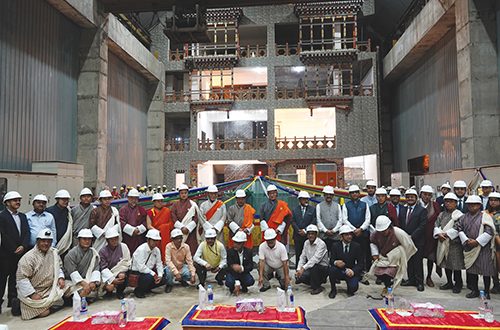Speculations of a pay hike start but there are some ground realities
The tariff rate for the 1020 MW Punatsangchu II (P II) project is likely to be Nu 5.10 per unit as this is the rate that has been accepted by the Indian side.
The levelized tariff, which is the average tariff over 35 years, is expected to be Nu 5.60 but this is yet to be confirmed.
The official announcement is likely to come in early September, as assured by a senior Indian official who came for the Punatsangchu Hydroelectric Project Authority (PHPA) II meeting.
Once the official announcement is made then senior Bhutanese officials are likely to head to Delhi to sign the Power Purchase Agreement (PPA), only after which power can start to be exported to India.
The expected annual revenue from P II is expected to be around Nu 20 billion (bn) a year, of which the loan repayment is Nu 8 bn and Operation and Maintenance (O&M) costs is expected to be Nu 2 bn a year.
This will leave around Nu 10 bn in actual revenue.
For this year, given that there was less generation since units had to come online one by one, the revenue expected is Nu 12 bn and the O&M costs is expected to be Nu 800 million (mn).
For the first two years after the commissioning of the project, loan does not have to be paid and the project will be under the Ministry of Energy and Natural Resources (MoENR) and so that will mean an enhanced revenue for the government.
After two years, DGPC will take over the project and the loan repayment of around Nu 8 bn will kick in. DGPC will pay taxes and dividends to the government at that stage apart from 15% Royalty Power or free power which the government can use to subsidize domestic users or use it as revenue.
The 13th Five-Year Plan (FYP) has projected a revenue of Nu 318 bn from domestic sources of which around Nu 22 bn or 6 percent is projected to come from P II for the entire plan period.
It is clear that the revenue from P II will exceed the plan projection, especially since the first two years are loan payment free.
This has led to some expectation among some public servants of a potential pay hike in line with past precedents when hikes were given after the commissioning of 336 MW Chukha, 1020 MW Tala, and a few months before the 720 MW Mangdechu was commissioned.
However, there are a few ground realities to contend with first. The first reality is that the 50 percent pay hike that civil servants got in 2023 came with a bill of Nu 6 bn a year, money that the government did not have due to which Nu 4 bn was funded by Bitcoin for 2023-2024. Bitcoin would fund the hike for another year from 2024-25 at another 4 bn which meant a total of Nu 8 bn in two years.
Now that P II has come online, this Nu 4 bn burden will be shifted to the P II project which means a chunk of P II revenue is already factored into carrying the 50 percent pay hike burden of 2023.
The second reality is that the 13th FYP has not factored in any pay hike and all the resources are tied up tightly. The projected revenue of the 13th FYP is Nu 318 bn for a plan size of Nu 512 bn.
A government official said they have only projected a revenue of Nu 3 to 4 bn a year from P II coming to Nu 22 bn in five years.
The official said that while P II will generate revenue, there are loans to be paid, O&M costs, depreciation and DHI will have to keep some reserves for future investment. This is not even taking into account the Nu 4 bn pay hike burden of 2023 shifting to P II.
The official said that another issue is that the grants and aid from certain developmental partners have reduced, especially in the case where countries like USA has pulled out or reduced funding to WHO and other UN bodies who also become more constrained in Bhutan as a result.
This is when the 13th FYP is important and there are so many competing developmental priorities.
The official said that a pay hike may only be possible if there is more than forecasted revenue and efficiency is improved doing more with less, otherwise there is no provision.
Another issue is that the 2022 and 2023 pay hikes created a huge salary gap between public servants and the struggling private sector. Already the entry level pay in the civil service and government corporations is equivalent to what managers get in the private sector.
Post democracy, the first pay hike was given in 2009 when a 35 to 55 percent hike was given with a higher hike for those at lower pay. The next pay hike was in 2014 with a 19 to 25 percent hike. In 2017 there was an increase in various allowances for teachers, health workers and local government leaders.
In 2019 there was a 6 to 35 percent hike with higher hikes for teachers, health workers and technical professionals.
In 2022 the clean wage was introduced which lead to a 5 to 26 percent hike with higher hikes for those lower down. Then in 2023 the big hike of a flat 50 percent hike came into play funded in large part by Bitcoins.
When this paper asked the Prime Minister Dasho Tshering Tobgay if a pay hike is possible due to P II, the Prime Minister said, “Haven’t looked into it yet.”
P II Commissioning
After nearly 14 years of construction and an investment of Nu 88.5 billion (bn), the P II project is now fully operational, with all six units generating power.
The final unit, with a capacity of 170MW, was successfully synchronized to the national grid on 28th August, bringing the project’s total installed capacity to 1,020MW.
The commissioning was carried out in phases. Units 1 and 2 came online in December 2024, followed by Unit 3 in March 2025 and Unit 4 in May. Unit 5 began generating electricity on 17th July 2025, paving the way for the integration of the last unit. With all units now active, the project is running at full capacity, further cementing Bhutan’s standing as a producer of clean energy.
Since 17th December last year, when the first two units began operation, P II has generated 2,160 million units of electricity. This has earned Nu 6.7 bn, of which Nu 2.82 bn has already been transferred to the Ministry of Finance, underlining its direct contribution to the national economy.
The project is expected to generate 4,357 million units of electricity annually
During the lean winter months, when river flows fall, the project will still provide 199MW of firm power, an important addition to Bhutan’s energy security.
Currently, 553 personnel are employed under the project, including 474 contract workers. Many of the skilled employees are expected to transition to operations and maintenance roles.
The project was initiated in July 2010 through a bilateral agreement between the Royal Government of Bhutan and the Government of India. Initially planned at 990MW, the capacity was later revised to 1,020MW. Despite delays and cost escalations, the commissioning of P II marks a milestone in Bhutan’s hydropower journey and shows the cooperation between both countries.
 The Bhutanese Leading the way.
The Bhutanese Leading the way.




